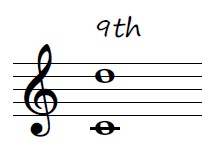Salford Piano Studio
A Compound interval is any interval larger than an octave.
Let’s have a look at a 9th.

We can think of this 9th in two ways:
- A Simple 9th
- A Compound 2nd
A 2nd and a 9th consist of the same note, only an octave higher.
Here it is on the piano:
Note: Compound intervals are identical to simple intervals in terms of their interval quality.
Let’s start with a simple interval this time.
This is a Major 3rd:
A Compound Major 3rd is also a Simple Major 10th
As always, it’s useful to see it on the piano:
Simple Vs. Compound Intervals
We usually write simple intervals up to 13th, that is a Compound 6th.
Use this as a guide:
Compound 2nd – Simple 9th
Compound 3rd – Simple 10th
Compound 4th – Simple 11th
Compound 5th – Simple 12th
Compound 6th – Simple 13th
Example
The Finale from Beethoven’s Piano Trio no. 1 starts with a Compound 3rd (a Simple 10th). He then fills that gap with descending E Flat Major notes.
